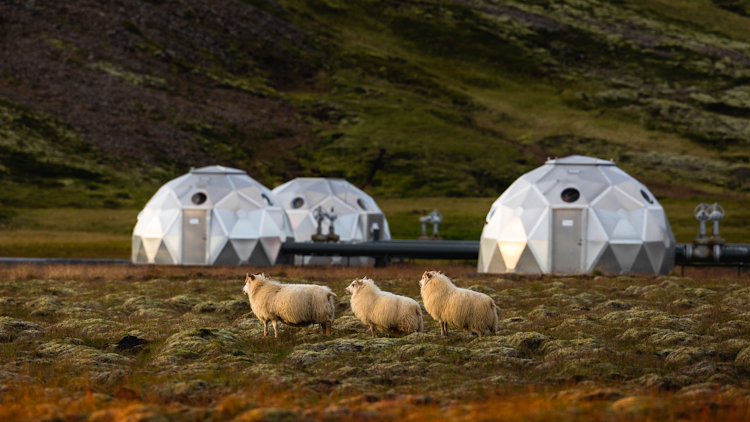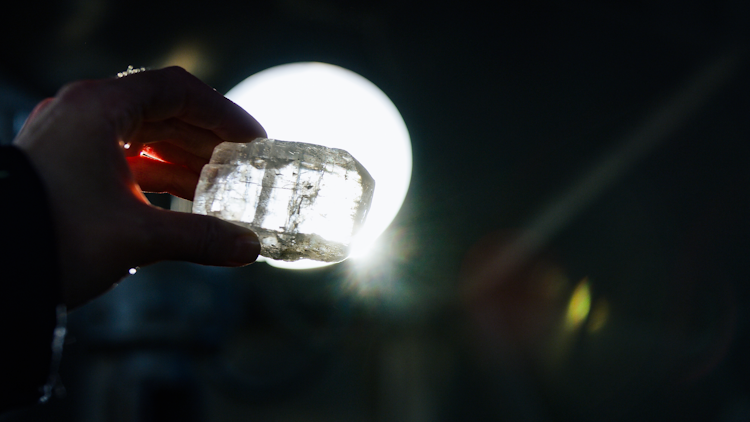🇮🇸 🇺🇸 Consortium wins $3 million in federal funding to study the feasibility of a first-of-a-kind hub for direct air capture in the Pacific Northwest
The consortium of leading scientists, technology developers, and nonprofit organizations will study the feasibility of deploying innovative technology to permanently remove past carbon dioxide emissions from the atmosphere and store them in subterranean basaltic rock in the Pacific Northwest, powered by the region’s significant low-carbon energy resources.
Thirteen organizations from across sectors—convened by the clean energy nonprofit RMI, the carbon mineralization company Carbfix, and the Pacific Northwest National Lab (PNNL)—have been awarded $3 million by the US Department of Energy (DOE) to study the feasibility of a regional hub for direct air capture (DAC), carbon mineralization, and carbon management in eastern Washington and neighboring states.
The Ankeron Carbon Management Hub would demonstrate technologies that extract legacy carbon emissions from the atmosphere and either utilize or permanently store them. The Pacific Northwest region is uniquely positioned to host a carbon management hub thanks to its abundant renewable energy sources as well as its unique geological formations suitable for turning billions of tons of carbon dioxide (CO2) into stone via mineralization. The hub project will help advance President Joe Biden’s Justice40 Initiative with a focus on community benefits and economic development, clean energy deployment, and spurring innovation in carbon management technologies.
The UN Intergovernmental Panel on Climate Change (IPCC) found that — alongside immediate and rapid cuts to fossil fuel emissions — eliminating existing emissions from the atmosphere through carbon dioxide removal (CDR) solutions, including DAC, will be critical to meeting the goals of the Paris Agreement. The Ankeron Hub will aim to demonstrate a viable pathway for DAC to reach the DOE Carbon Negative Shot target of <$100/ton of durable CO2 removals by 2032.
The two-year award, provided under the Bipartisan Infrastructure Law’s Regional Direct Air Capture Hubs program, will fund initial work conceptualizing, designing, and assessing the feasibility of building a hub.
“We need tools to remove carbon from the atmosphere that are sustainable at scale. DAC technology is a promising candidate. The decisions that DAC hubs make this decade on technology, energy, and community benefits will have a massive impact on how DAC evolves and scales,” said Daniel Pike, principal of the Carbon Dioxide Removal Initiative at RMI and the project’s director. “Our consortium is determined to get it right. As we assess the feasibility of this concept, we will hold ourselves accountable to local communities and the scientific community. We will find ways to build up clean energy systems in the region, not overload them.”
RMI will lead the design of the hub’s governance and business model while Carbfix and PNNL will lead many scientific and technical elements of the study. Other partners for this first phase include AES, the leading developer of clean energy in the United States, and a suite of leading climate technology developers: Blue Planet, Heirloom, LanzaTech, Removr, Sustaera, and Twelve. Washington State University Tri-Cities will support community engagement for the project, and the Washington State Department of Natural Resources will serve as a technical advisory partner. Fluor will serve as the integrating EPC provider.
The consortium expects and intends to add additional partners, should it advance to future phases.
“Averting the climate crisis requires capturing and storing historical CO2 emissions, in addition to other efforts. We are proud and excited to contribute our proven carbon mineralization technology to this important project in collaboration with outstanding partners,” said Dr. Bergur Sigfússon, head of CO2 Capture and Injection at Carbfix and its principal investigator for the project. “Scientific integrity is key as we move both existing and developing mitigating technologies to scale to achieve climate recovery. In this we will continue to hold ourselves to the highest standards, building on more than a decade of successful operational experience of mineralizing CO2 in Iceland.”
Three DAC companies will participate in this initial phase. Their technologies have high potential, can be powered entirely by electricity, and are well-suited to the region. The companies will work with RMI, Carbfix, and PNNL to assess the technological and economic feasibility of demonstrating their technologies in the region, through a hub that delivers carbon removal, a stronger clean energy system, high-quality local jobs, and benefits to local communities and environments.
“Just a few months after Heirloom’s world-first storage of atmospheric CO2 into concrete, we’re thrilled to see that the Ankeron Hub has been selected by the DOE because it opens up the exciting new frontier of carbon mineralization as a permanent storage method for CO2. We’re looking forward to bringing our nature-inspired Direct Air Capture technology — that harnesses the natural power of limestone to pull CO2 from the atmosphere — to the Ankeron Hub,” said Max Scholten, Head of Commercialization at Heirloom.
In the feasibility study, Ankeron will center community engagement in the hub design and community benefits plan. Two deeply rooted local institutions, PNNL and the Washington State University Tri-Cities, will drive this work. Both possess deep local experience in workforce development, community engagement, and outreach related to complex energy and geology projects.
“I am thrilled that WSU Tri-Cities students will be at the forefront of DAC research and community outreach activities in partnership with PNNL,” said Jillian Cadwell, Research Associate and Adjunct Professor of Civil Engineering at Washington State University Tri-Cities. “As we work to educate the workforce of the future, this opportunity is right in line with our Empowering the Future Energy Workforce plan and what the work students are doing through the Clean Energy Ambassadors Network.”
The Ankeron Hub is one of several projects selected for the first round of DOE funding in a process that will eventually select four DAC hubs across the United States, drawing on a total of $3.5 billion in federal funding. Each hub must prove it can capture from the air and then store or utilize at least one million metric tons of CO2 per year, as well as create high-quality job opportunities.
“This project brings together three fields of carbontech — DAC, carbon mineralization and carbon utilization — into one hub,” said Curt Graham, Office of Technology Vice President at Fluor. “We are excited to collaborate with innovative leaders in the CDR space while using our experience in Washington State and carbon management to advance sustainable solutions that support climate goals.”
“At Removr, we look forward to investing in the Pacific Northwest to deploy our proven, safe, and energy-efficient technology for large-scale atmospheric carbon removal. We feel privileged to be contributing our decades of energy infrastructure expertise from Norway to such a strong, innovative, and diverse consortium,” said Einar Tyssen, CEO at Removr.
“Collaboration is essential for creating a just, regenerative, and climate-positive future. We look forward to working with the other members of the Ankeron DAC Hub to revolutionize the transformation of captured CO2 through the development of DAC technology. This innovation enables society to have the fuels and materials that drive our economy without relying on fossil fuel extraction,” said Nicholas Flanders, Co-Founder and CEO of Twelve.

About RMI
RMI, founded as Rocky Mountain Institute, is an independent nonprofit founded in 1982 that transforms global energy systems through market-driven solutions to align with a 1.5°C future and secure a clean, prosperous, zero-carbon future for all. We work in the world’s most critical geographies and engage businesses, policymakers, communities, and NGOs to identify and scale energy system interventions that will cut greenhouse gas emissions at least 50 percent by 2030. RMI has offices in Basalt and Boulder, Colorado; New York City; Oakland, California; Washington, D.C.; and Beijing. More information on RMI can be found at www.rmi.org or follow us on Twitter @RockyMtnInst.
About Carbfix
Carbfix is the world’s first CO2 mineral storage operator. Since 2012, Carbfix has mineralized over 90 thousand tons of CO2 in Iceland using proprietary technology that accelerates natural processes. This proven, safe, permanent, and cost-effective carbon storage solution is ripe for significant upscaling both in Iceland and worldwide. Carbfix’s largest current project is Coda Terminal, recipient of a EUR 115M grant from the EU’s Innovation Fund, with an expected capacity to mineralize 3 million tons of CO2 annually. For more information, please visit www.carbfix.com or follow us on Twitter and Linkedin @Carbfix.
About Removr
Removr is a Norwegian Direct Air Capture (DAC) company that aims to scale carbon removal to help reduce global warming. Leveraging the best available technology, unique Nordic advantages, and a world-class team and partners, Removr’s ambition is to build the world’s first 1-million-ton solid sorbent DAC plant to become a global leader in carbon removal. Removr is owned by Vanir Green Industries (VGI), a Nordic business builder and GreenCap Solutions. To learn more, please visit www.removr.no or follow us on LinkedIn.
About Twelve
Twelve is the carbon transformation company, a new kind of chemical company built for the climate era. We make essential products from air, not oil. Our groundbreaking technology eliminates emissions by transforming CO2 into critical chemicals, materials and fuels that today are made from fossil fuels. We call it carbon transformation, and it fundamentally changes how we can address climate change, reduce emissions and reverse the carbon imbalance. Reinventing what it means to be a chemical company, we’re on a mission to create a climate positive world and a fossil free future through the power of chemistry. Learn more at www.twelve.co.
About Washington State University Tri-Cities
Washington State University Tri-Cities is one of six campuses in the WSU system and is located in Richland, Washington along the beautiful Columbia River on shared traditional homelands of the Confederated Tribes of the Umatilla Indian Reservation and the Confederated Tribes and Bands of the Yakama Nation. Known for its strengths in STEM programs, students experience hands-on, project-based learning in a personalized small-school setting. As a leading public research university with a focus on energy, environment and agriculture, WSU Tri-Cities delivers career-connected learning and innovative research that addresses economic and social challenges.
The digital emissions from this story are an estimated 0.2g to 1,0g CO₂ per pageview.
Originally published on 14 August.
